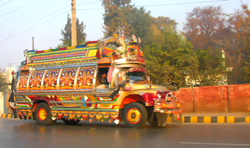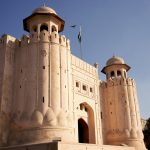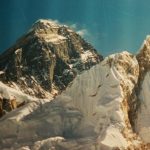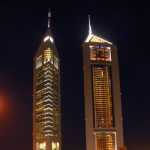Peshawar, Pakistan
December 2005
 Some of you have wondered what has happened to us in the wilds of Pakistan and Afghanistan, since it’s been a while that I wrote. Well, we have since made our way across Pakistan into the Northwest Frontier Province. If there is any “Wild West” left in the world, then this frontier area of Pakistan and Afghanistan is it. And the town of Peshawar has got to be the “Dodge City”, then. Far larger and spread out than I imagined, Peshawar is actually a pretty comfortable town with all the amenities. It also suffers from the usual curses of Asian cities such as excessive air pollution, but we found it to be surprisingly uncrowded. My uncle Waheed actually lived here in the early 1980’s and, as a young doctor, stayed busy treating all those Afghan war refugees who back then poured across the Khyber Pass to escape the brutal Soviet invasion of Afghanistan. Most of those refugees are gone now. Those who stayed have more or less melted into the city and become part of its economy.
Some of you have wondered what has happened to us in the wilds of Pakistan and Afghanistan, since it’s been a while that I wrote. Well, we have since made our way across Pakistan into the Northwest Frontier Province. If there is any “Wild West” left in the world, then this frontier area of Pakistan and Afghanistan is it. And the town of Peshawar has got to be the “Dodge City”, then. Far larger and spread out than I imagined, Peshawar is actually a pretty comfortable town with all the amenities. It also suffers from the usual curses of Asian cities such as excessive air pollution, but we found it to be surprisingly uncrowded. My uncle Waheed actually lived here in the early 1980’s and, as a young doctor, stayed busy treating all those Afghan war refugees who back then poured across the Khyber Pass to escape the brutal Soviet invasion of Afghanistan. Most of those refugees are gone now. Those who stayed have more or less melted into the city and become part of its economy.
We found it best to rid ourselves of our western wear and find some of the local clothing, because no one in Peshawar wears anything western and we really looked like clowns upon our arrival. For Men, the favored garb is the “sharwal kameez”, a combination of extremely baggy pants (two and a half of me could fit inside the one I got) and a matching shirt that drops down to the kneecaps. It is worn over the pants and always has to match. Usually most men drape a large shawl around themselves and on their heads they wear something too. Turbans are common for older dudes, but I preferred the flat woolen “Pakol” caps that the Afghans across the border wear. Personally I think I also look far too asinine in a turban. Women, it seemed, could wear anything they wanted as long as it was a light blue “burqa”. This is the notorious all shrouding cloth with a sown in mesh for the face that the Taliban regime imposed on the women in Afghanistan back when they were in power. Here women still wore it out on the street and, it seemed, no one dared to be seen outside without one.
As a gate way to the Khyber Pass and the ancient silk route to Central Asia, Peshawar has been a trading center and even today it is chock full of crowded aromatic bazaars and caravans of colorfully painted heavy trucks that have now replaced the camel caravans of the old days. Nowhere else have I seen trucks as adorned as here in north western Pakistan: all kinds of shiny metal ornaments hang from every possible edge and corner. The colors on the sheet metal are wild and unmatching. Even small chunks of mirrors are embedded all over the vehicle’s body for that extra glitter. But aside from the distraction that the trucks offer, Peshawar is more that just Pakistani bazaars. The British left their imprints in the colonial administration buildings and universities and forts. Before them, other imperial invaders such as the Moghul emperors built their massive stone forts as well. Nowadays these crumbling but still magnificent forts serve as police and military headquarters in this heavily militarized country. I noticed the long arm of the law everywhere in Peshawar, the airports, the highway to Khyber Pass and in the bazaars. But out in the mountainous countryside the Pashtun tribes still run their affairs as they have for millennia.
 These fair skinned people were a source of fascination for me, as they are fiercely independent from the rest of Pakistan. No amount of military presence now or in the past by the British, Indians, or Pakistanis has been able to penetrate their livelihoods and abolish the all important and ancient tribal code of conduct, the “Pashtunwali”. Historically the Pashtuns have populated the border areas of Pakistan and Afghanistan and, to this day, reject the artificially drawn border by the British, known as the Durant line. As there is no effective government presence from either side, the area is for all practical purposes a true wild west. Taliban remnants still hide in these rugged borderlands. All kinds of smugglers, especially of heroin, find it easy to ply their trade. The code of Pashtunwali makes it very difficult for any outside invaders or government to impose their rules and the tribes allow all kinds of outlaws to pass through their lands provided they pay their tolls. On the Khyber Pass itself, no one, not even the British colonizers could pass through without paying tolls or meeting fierce resistance. Banditry is still common to this day. Past Peshawar the well graded highway to the Pass winds past miles of little fields and orchards watered by an ancient system of canals until the gradient gets steeper in the foothills of what is essentially the Hindukush mountain range. The town of Landikotal is the last stop before the Afghan border and again, there is a heavy Pakistani military presence. From here the mountains become more rugged and drier. The hills on either side of the road edge closer and eventually turn into vertical cliffs. At its narrowest, the Khyber Pass is a mere 20 yards wide, just enough for the road to cling to one cliff, right next to the dry and gravelly stream bed. At less than 5000 feet elevation this is by far the lowest pass in the entire range and, thus, the easiest for all Central Asian invaders of the Indian subcontinent to go through. Alexander the Great fought his way through this area.
These fair skinned people were a source of fascination for me, as they are fiercely independent from the rest of Pakistan. No amount of military presence now or in the past by the British, Indians, or Pakistanis has been able to penetrate their livelihoods and abolish the all important and ancient tribal code of conduct, the “Pashtunwali”. Historically the Pashtuns have populated the border areas of Pakistan and Afghanistan and, to this day, reject the artificially drawn border by the British, known as the Durant line. As there is no effective government presence from either side, the area is for all practical purposes a true wild west. Taliban remnants still hide in these rugged borderlands. All kinds of smugglers, especially of heroin, find it easy to ply their trade. The code of Pashtunwali makes it very difficult for any outside invaders or government to impose their rules and the tribes allow all kinds of outlaws to pass through their lands provided they pay their tolls. On the Khyber Pass itself, no one, not even the British colonizers could pass through without paying tolls or meeting fierce resistance. Banditry is still common to this day. Past Peshawar the well graded highway to the Pass winds past miles of little fields and orchards watered by an ancient system of canals until the gradient gets steeper in the foothills of what is essentially the Hindukush mountain range. The town of Landikotal is the last stop before the Afghan border and again, there is a heavy Pakistani military presence. From here the mountains become more rugged and drier. The hills on either side of the road edge closer and eventually turn into vertical cliffs. At its narrowest, the Khyber Pass is a mere 20 yards wide, just enough for the road to cling to one cliff, right next to the dry and gravelly stream bed. At less than 5000 feet elevation this is by far the lowest pass in the entire range and, thus, the easiest for all Central Asian invaders of the Indian subcontinent to go through. Alexander the Great fought his way through this area.
Overall we had no problems getting around anywhere in the Peshawar area for three major reasons: Waheed speaks Urdu, the Pakistani language and Pashto, the language of the Pashtuns; we had some excellent local connections to take us to places; we are both Pashtuns ourselves, like more than half of all Afghans. All this makes travel through this region a no brainer, but for a complete foreigner it does not seem so easy. In fact, throughout our time in the Northwest Frontier I didn’t really run into any foreigners except a few at a fancy hotel, who had armed guards outside keeping a watchful eye. Although all the gun shops of Peshawar, where you could buy anything from an AK47 to rocket propelled grenades, are mostly gone or gone underground now, the wild spirit is still very much in the air. Now I am curious if Afghanistan, which is next on our itinerary, is also anything like the Northwest Frontier.







Leave a Reply